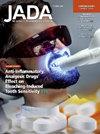Dental diagnostic errors and characteristics associated with claims in the United States, 1990-2020
IF 3.5
2区 医学
Q1 DENTISTRY, ORAL SURGERY & MEDICINE
引用次数: 0
Abstract
Background
Little is known about the magnitude of diagnostic errors in dentistry. The authors aimed to examine the prevalence of and demographic characteristics associated with dental diagnostic errors.
Methods
A cross-sectional analysis of dental paid malpractice claims from the National Practitioner Data Bank spanning from 1990 through 2020 identified the characteristics of the claims. The authors categorized the claims into diagnostic and others. Descriptive statistics, χ2 tests, and regression analyses were used to assess the provider and patient characteristics associated with the claims.
Results
Of 58,229 dental paid claims, 8.7% were diagnostic claims, of which missed diagnoses (78.6%) were the most common. More diagnostic claims involved female patients (59.7%) and patients aged 50 through 59 years (22.2%) and providers aged 40 through 49 years (29.4%) who graduated from 1970 through 1979 (27.4%) and were from the Northeast region of the United States (32.2%) (P < .05).
Conclusions
Dental diagnostic errors, a major preventable cause of malpractice claims, have remained steady since 2008, and nondiagnostic claims decreased over time. Significant differences in patient and provider demographic characteristics were linked to these claims. Further analysis of dental diagnostic errors could guide tools to reduce these errors and enhance patient safety.
Practical Implications
The results of the study provide key insights for policy makers to understand the need for targeted strategies improving diagnostic accuracy, patient safety, and clinical outcomes, and guide provider training and continuing education.
1990-2020年美国与索赔相关的牙科诊断错误和特征
背景:人们对牙科诊断错误的严重程度知之甚少。作者旨在研究与牙科诊断错误相关的患病率和人口统计学特征。方法对1990年至2020年国家从业者数据库中牙科医疗事故付费索赔进行横断面分析,确定索赔的特征。作者将这些索赔分为诊断性索赔和其他索赔。使用描述性统计、χ2检验和回归分析来评估与索赔相关的提供者和患者特征。结果58,229例牙科理赔中,诊断理赔占8.7%,其中漏诊占78.6%。更多的诊断索赔涉及女性患者(59.7%),50至59岁的患者(22.2%)和40至49岁的提供者(29.4%),1970至1979年毕业(27.4%),来自美国东北地区(32.2%)(P <;. 05)。结论牙科诊断错误是医疗事故索赔的主要可预防原因,自2008年以来一直保持稳定,非诊断索赔随着时间的推移而下降。患者和提供者人口学特征的显著差异与这些说法有关。进一步分析牙科诊断错误可以指导工具减少这些错误并提高患者安全。该研究的结果为政策制定者提供了关键的见解,以了解有针对性的策略的必要性,以提高诊断准确性,患者安全性和临床结果,并指导提供者培训和继续教育。
本文章由计算机程序翻译,如有差异,请以英文原文为准。
求助全文
约1分钟内获得全文
求助全文
来源期刊

Journal of the American Dental Association
医学-牙科与口腔外科
CiteScore
5.30
自引率
10.30%
发文量
221
审稿时长
34 days
期刊介绍:
There is not a single source or solution to help dentists in their quest for lifelong learning, improving dental practice, and dental well-being. JADA+, along with The Journal of the American Dental Association, is striving to do just that, bringing together practical content covering dentistry topics and procedures to help dentists—both general dentists and specialists—provide better patient care and improve oral health and well-being. This is a work in progress; as we add more content, covering more topics of interest, it will continue to expand, becoming an ever-more essential source of oral health knowledge.
 求助内容:
求助内容: 应助结果提醒方式:
应助结果提醒方式:


